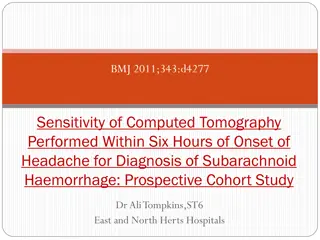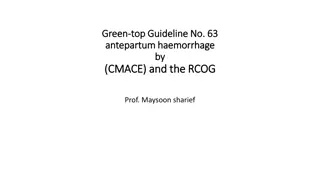
Haemorrhage: Symptoms, Causes, and Treatment
Explore the definition of haemorrhage, its symptoms, causes, and treatment options. Learn about internal and external bleeding, traumatic injuries, medical conditions, and more. Understand how haemorrhage can occur in various areas of the body and the importance of timely intervention in addressing this condition.
Uploaded on | 5 Views
Download Presentation

Please find below an Image/Link to download the presentation.
The content on the website is provided AS IS for your information and personal use only. It may not be sold, licensed, or shared on other websites without obtaining consent from the author. If you encounter any issues during the download, it is possible that the publisher has removed the file from their server.
You are allowed to download the files provided on this website for personal or commercial use, subject to the condition that they are used lawfully. All files are the property of their respective owners.
The content on the website is provided AS IS for your information and personal use only. It may not be sold, licensed, or shared on other websites without obtaining consent from the author.
E N D
Presentation Transcript
StudyMafia.Org Haemorrhage Submitted To: Submitted By: Studymafia.org Studymafia.org
Table Contents Definition Introduction Symptoms of Haemorrhage Causes of Haemorrhage Types of Haemorrhage Treatment of Haemorrhage Conclusion 2
Definition Bleeding, also called hemorrhage, is the name used to describe blood loss. It can refer to blood loss inside the body, called internal bleeding, or to blood loss outside of the body, called external bleeding. 3
Introduction Blood loss can occur in almost any area of the body. Internal bleeding occurs when blood leaks out through a damaged blood vessel or organ. External bleeding happens when blood exits through a break in the skin. Blood loss from bleeding tissue can also be apparent when blood exits through a natural opening in the body, 4
Causes of Haemorrhage Traumatic bleeding An injury can cause traumatic bleeding. Traumatic injuries vary in their severity. Common types of traumatic injury include: abrasions (scrapes) that don t penetrate too far below the skin hematoma or bruises lacerations (cuts) puncture wounds from items like needles, nails, or knives 6
Causes of Haemorrhage Medical conditions There are also some medical conditions that can cause bleeding. Bleeding due to a medical condition is less common than traumatic bleeding. Conditions that can cause bleeding include: hemophilia leukemia liver disease menorrhagia 7
Causes of Haemorrhage Alcohol, drug or tobacco use that is heavy or long-term (bleeding in the brain). Blood clotting disorders. Cancer. Complications from medical procedures, such as surgery or childbirth. Damage to an internal organ. 8
Causes of Haemorrhage Hereditary (inherited) disorders, such as hemophilia and hereditary hemorrhagic telangiectasia. Injuries, such as cuts or puncture wounds, bone fracture or traumatic brain injury. Violence, such as a gunshot or knife wound, or physical abuse. Viruses that attack the blood vessels, such as viral hemorrhagic fever. 9
Causes of Haemorrhage Medicines Some medicines and certain treatments can increase your chances of bleeding, or even cause bleeding. Medications that may be responsible for bleeding include: blood thinners antibiotics, when used on a long-term basis radiation therapy 10
Types of Haemorrhage Epidural bleed. This is when blood collects between your skull and the thick outer layer, called the dura mater. Without treatment, it can make your blood pressure rise, give you trouble breathing, cause brain damage, or lead to death. 11
Types of Haemorrhage Subdural bleed. This is when blood leaks between your dura mater and the thin layer beneath it, called the arachnoid mater. There are two main kinds of subdural bleeds: The acute type develops fast, and it s linked to a death rate that ranges from about 37% to 90%. It s common for people who survive one to have permanent brain damage. 12
Types of Haemorrhage Subarachnoid bleed. This is when blood collects below the arachnoid mater and above the delicate inner layer beneath it, the pia mater. Without treatment, it can lead to permanent brain damage and death. 13
Types of Haemorrhage Intracerebral hemorrhage. This is when blood pools in the tissue of your brain. It s the second most common cause of stroke as well as the deadliest. It s usually due to long-term, untreated high blood pressure. 14
Treatment of Haemorrhage Treatment for hemorrhage depends on: Where it is in the body. How serious the hemorrhage is. How much blood may have been lost. How the person is feeling overall (for example, symptoms or other injuries). Seek immediate medical attention for external bleeding that won t stop, or for suspected internal bleeding. 15
Treatment of Haemorrhage Sometimes, external bleeding can be stopped with first aid: Apply pressure to the wound with your hands. Find a dressing (clean cloth) and press on the wound. Tie a tourniquet near the wound, but toward the heart. You can make a tourniquet from something tied very tightly, such as a stretchy band, cloth or belt. Call 911. 16
Treatment of Haemorrhage A person can bleed to death in 5 minutes. Bystanders may be able to save a life before emergency personnel can arrive. There is a national campaign called Stop the Bleed to teach anyone how to stop bleeding. People in mass casualty events have died from blood loss even when their wounds shouldn t have been fatal. 17
Treatment of Haemorrhage First aid for traumatic bleeding It s possible to treat external traumatic bleeding. Seek emergency help if the person is having any of the emergency signs listed above and if you need help to stop the bleeding. The person who s bleeding should try to remain calm to keep their heart rate and blood pressure controlled. Either heart rate or blood pressure being too high will increase the speed of bleeding. 18
Treatment of Haemorrhage Treat high blood pressure. Studies show that 80% of cerebral hemorrhage patients have a history of high blood pressure. The single most important thing you can do is control yours through diet, exercise, and medication. Don t smoke. Don t use drugs. Cocaine, for example, can increase the risk of bleeding in the brain. Drive carefully, and wear your seat belt. 19
Treatment of Haemorrhage If you ride a motorcycle, bicycle or skateboard, always wear a helmet. Investigate corrective surgery. If you suffer from abnormalities, such as aneurysms, surgery may help to prevent future bleeding. Be careful with warfarin (Coumadin). If you take this blood-thinning drug follow up regularly with your doctor to make sure your blood levels are in the correct range. 20
Conclusion Hemorrhage is loss of blood from a damaged blood vessel. It can be minor such as a bruise or major such as damage to an internal organ. External bleeding is visible and may be easier to notice, but be aware of the signs of internal bleeding. Seek medical attention if you are unsure. 21
Thanks To StudyMafia.org






